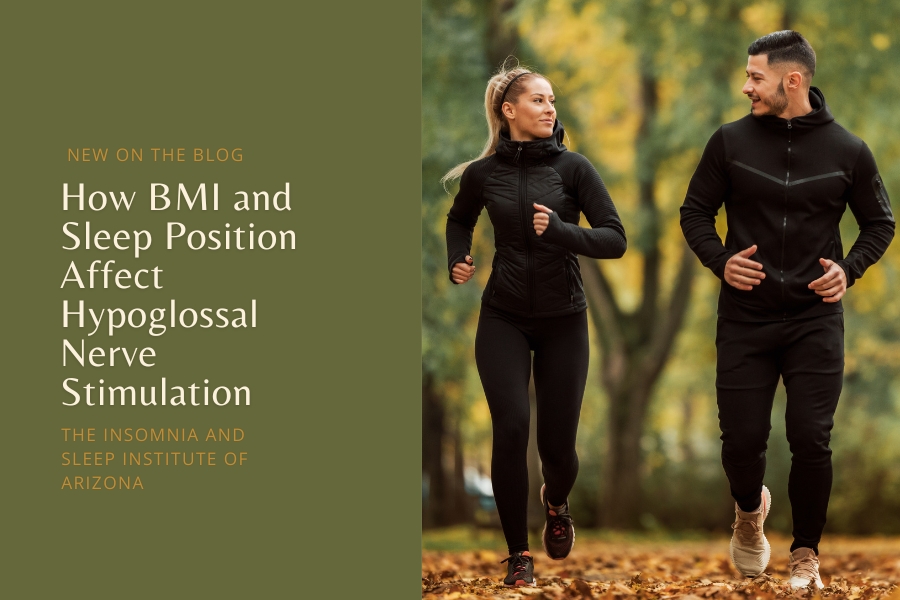Recent studies show that body mass index (BMI) and sleeping on your back can influence how well hypoglossal nerve stimulation (HNS) works. Knowing about these factors could help you get more out of your treatment. It may also lead to better sleep quality. Small changes might make a big difference.
What is Hypoglossal Nerve Stimulation?
Hypoglossal nerve stimulation (HNS) is a treatment for people with obstructive sleep apnea (OSA). It’s especially helpful for those who find CPAP therapy difficult to use. OSA happens when the throat muscles relax too much during sleep, blocking the airway. This causes breathing interruptions that can harm sleep quality and health.
HNS is a procedure where a small device is implanted under the skin, usually near the collarbone. The device sends electrical signals to the hypoglossal nerve, which controls tongue movement. This stimulation helps move the tongue forward while you sleep. It prevents the tongue from blocking the airway and causing obstruction.
HNS works only while you’re sleeping. It helps you keep your airway open without needing a mask or tubes. You can easily turn it on or off with a remote. It’s just simple to use.
Success Rates and Effectiveness
Studies have shown that hypoglossal nerve stimulation can significantly reduce the number of apneas (pauses in breathing) experienced during sleep. For example, one study published found that patients using HNS experienced a 68% reduction in the apnea-hypopnea index (AHI), a measure of the severity of sleep apnea. Moreover, another study reported that patients using HNS saw improvements in their sleep quality and overall well-being.
But HNS isn’t for everyone with obstructive sleep apnea. It’s usually recommended for those with moderate to severe OSA who aren’t significantly overweight and can’t use CPAP therapy. The treatment also requires that the patient’s airway structure is suited for nerve stimulation. This helps ensure the therapy works effectively.
Body Mass Index and Sleep Apnea
Body Mass Index (BMI) is a number based on a person’s weight and height. It’s often used to determine if someone is underweight, normal weight, overweight, or obese.
The formula is simple: BMI = weight (kg) / height (m²). BMI doesn’t directly measure body fat, but it gives a good estimate of whether someone’s weight might lead to health risks.
BMI Categories and Their Impact on Sleep Apnea
- Underweight: BMI < 18.5
- Normal weight: BMI 18.5–24.9
- Overweight: BMI 25–29.9
- Obese: BMI ≥ 30
Higher BMI is strongly associated with an increased risk of developing obstructive sleep apnea. According to the experts, over 70% of people with OSA are classified as obese. Excess body fat, particularly around the neck and upper airway, leads to the narrowing of the airway, making it more likely to collapse during sleep. And for every unit increase in BMI, the risk of developing OSA also increases by 14%.
How Obesity Exacerbates Sleep Apnea
Fat deposits around the neck can narrow the airway, making it harder to breathe. This increases resistance and raises the chance of the airway collapsing. Obesity also reduces lung volume and affects how the lungs work. Together, these factors raise the risk of obstructive sleep apnea (OSA).
BMI also is important in determining the appropriate treatment for OSA. Patients with a higher BMI may not respond to treatments like CPAP or HNS as well as those with a lower BMI. Weight loss, in some cases, can alleviate the severity of OSA, as it reduces fat accumulation around the airway. Experts stated that a 10% weight loss can lead to a 20% reduction in sleep apnea severity.
Supine Sleep and Its Effects on OSA
Sleeping on your back, known as supine sleep, can affect how severe obstructive sleep apnea (OSA) is. OSA happens when throat muscles relax too much during sleep, causing the airway to partially or fully collapse.
This leads to pauses in breathing, which disrupts sleep and can cause health problems. Sleep position is important in managing OSA. Knowing how sleeping on your back affects OSA can help people make better choices to improve their sleep.
Why Supine Sleep Worsens OSA
When someone with OSA sleeps on their back, gravity causes issues. In this position, the tongue and throat tissues fall back toward the airway. This increases the chances of airway blockage. As a result, breathing gets interrupted more often during sleep. Sleeping on the back, in short, makes airway collapse more likely.
For those already diagnosed with OSA, supine sleep can exacerbate the condition. Research shows that OSA is more severe in the supine position. According to a study published, around 60% of individuals with OSA experience what is known as “positional OSA” where symptoms are worse when sleeping on the back compared to side-sleeping. This means that sleep position plays a significant role in the frequency and severity of apnea episodes.
New Research: Hypoglossal Nerve Stimulation Changes With Body Mass Index and Supine Sleep
Recently, a cohort study researched how factors such as body mass index (BMI) and supine sleep affect the success of HGNS in treating OSA. This research provides essential understanding for clinicians and patients alike.
Is Hypoglossal Nerve Stimulation an Effective Treatment for Obstructive Sleep Apnea?
Researchers conducted a study to see how effective hypoglossal nerve stimulation (HGNS) is for treating obstructive sleep apnea (OSA). They also wanted to know if a patient’s body mass index (BMI) could predict how well the treatment works. The study involved 76 patients who received HGNS implants. These procedures took place at Washington University Medical Center between April 2019 and January 2023.
Of the 76 participants, 59 (78%) experienced a positive response to HGNS. This was defined as a 50% or greater reduction in the Apnea-Hypopnea Index (AHI) score, with a post-treatment AHI of fewer than 15 events per hour.
The median preimplantation AHI was 29.3 events per hour, and after HGNS therapy, this dropped to a median of 5.3 events per hour — an impressive reduction that highlights the potential of HGNS for many patients.
This study supports the idea that HGNS can be a good option for treating OSA, especially for people who struggle with CPAP. The drop in AHI scores shows how effective this therapy is. It helps improve sleep quality by lowering the number of breathing interruptions.
The Impact of Body Mass Index on HGNS Response
Researchers found that patients with a BMI of 32 to 35 were 75% less likely to respond to HGNS than those with a BMI of 32 or less. This suggests that higher BMI may reduce the effectiveness of HGNS for treating OSA.
People with more fat around the upper airway may benefit less from the nerve stimulation that moves the tongue forward to prevent airway collapse. Those with higher BMIs might therefore need alternative treatments for OSA.
If you’re thinking about HGNS therapy, it’s important to know how BMI can affect the results. People with higher BMI should talk to their healthcare provider to see if weight loss could help improve the treatment’s success. Other options like CPAP or lifestyle changes might be better in some cases.
Supine Sleep and Its Effects on HGNS Response
For those considering HGNS therapy, it is important to understand how BMI can influence the outcome of treatment. When patients sleep in the supine position, gravity pulls the tongue and soft tissues backward, increasing the risk of airway collapse. The study also examined whether HGNS is as effective for patients who sleep in the supine position.
Of the 44 patients in the study who primarily slept on their backs, only 39% responded to HGNS. Those who did respond saw a big drop in their supine AHI, going from 46.3 events per hour before implantation to 21.8 after. This shows a meaningful improvement in their condition. However, it also highlights that sleeping on your back can reduce the overall effectiveness of HGNS. The study suggests supine sleeping might impact the treatment’s success.
For patients receiving HGNS therapy, sleeping on their side may improve results, especially for those who usually sleep on their backs. Healthcare providers should educate patients about how their sleep position can impact the treatment. Encouraging side-sleeping could lead to better outcomes.
Why The Insomnia and Sleep Institute of Arizona Is Your Partner in Better Sleep
The Insomnia and Sleep Institute of Arizona knows every case of obstructive sleep apnea is unique. Our team of sleep experts creates personalized treatment plans. We offer advanced options like the Inspire implant (hypoglossal nerve stimulation or HGNS) for those who can’t tolerate CPAP therapy.
If you’ve been diagnosed with OSA and need treatment options, we can help. Our team will assess factors like your BMI, sleep position, and health to see if the Inspire implant or other therapies are right for you.
We’re here to improve your sleep and health with comprehensive care and years of experience in treating OSA. Contact us.
References:
A, C. (2015, June 26). Sleep Apnea Indicators | BMI and Neck Circumference. Sleep Group Solutions. https://join.sleepgroupsolutions.com/25/sgs-sleep-blog/two-significant-indicators-of-sleep-apnea-bmi-and-neck-circumference/
Edwards, B. A., Joosten, S. A., & Sands, S. A. (2024). A Detailed Mechanistic Understanding of Positional and Nonpositional OSA. CHEST Journal, 166(1), 7–9. https://doi.org/10.1016/j.chest.2024.03.025
Malhotra, A., Heilmann, C. R., Banerjee, K. K., Dunn, J. P., Bunck, M. C., & Bednarik, J. (2024). Weight reduction and the impact on apnea-hypopnea index: A systematic meta-analysis. Sleep Medicine, 121, 26–31. https://doi.org/10.1016/j.sleep.2024.06.014
Patel, R. M., Wang, H. Z., Jamro, E. L., Lindburg, M. R., Jackson, R. S., Malhotra, R. K., Lucey, B. P., & Landsness, E. C. (2024). Response to Hypoglossal Nerve Stimulation Changes With Body Mass Index and Supine Sleep. JAMA Otolaryngology–Head & Neck Surgery, 150(5), 421–421. https://doi.org/10.1001/jamaoto.2024.0261
Pascoe, M., Wang, L., Aylor, J., Mehra, R., Kominsky, A., Foldvary-Schaefer, N., Shah, V., Waters, T., & Walia, H. K. (2022). Association of Hypoglossal Nerve Stimulation With Improvements in Long-term, Patient-Reported Outcomes and Comparison With Positive Airway Pressure for Patients With Obstructive Sleep Apnea. JAMA Otolaryngology–Head & Neck Surgery, 148(1), 61–61. https://doi.org/10.1001/jamaoto.2021.2245
Slowik, J. M., Abdulghani Sankari, & Collen, J. F. (2024, March 21). Obstructive Sleep Apnea. Nih.gov; StatPearls Publishing. https://www.ncbi.nlm.nih.gov/books/NBK459252/
Sanchez, A. M., Germany, R., Lozier, M. R., Schweitzer, M. D., Semaan Kosseifi, & Anand, R. (2020). Central sleep apnea and atrial fibrillation: A review on pathophysiological mechanisms and therapeutic implications. IJC Heart & Vasculature, 30, 100527–100527. https://doi.org/10.1016/j.ijcha.2020.100527
Wolk, R., Abu S.M. Shamsuzzaman, & Somers, V. K. (2003). Obesity, Sleep Apnea, and
Hypertension. Hypertension, 42(6), 1067–1074.
https://doi.org/10.1161/01.hyp.0000101686.98973.a3
Note: The content presented here is based on research and is intended for informational purposes only. Always seek medical advice for any health-related concerns.





